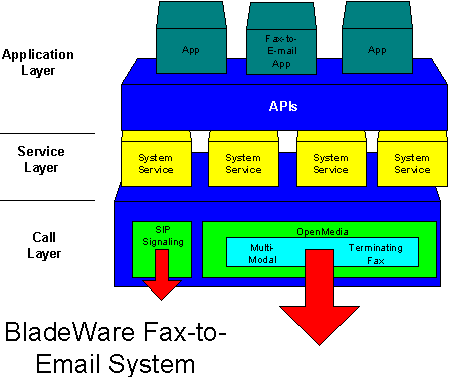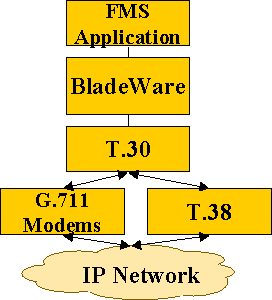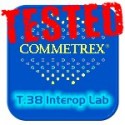BladeWare™ Fax to Email Media Server (Fax to Email) is a BladeWare application that directly receives incoming SIP-based calls. It extracts the called number for the inbound call and uses it to query a database to retrieve fax and e-mail options. If the database lookup succeeds, the fax operation is completed and the result e-mailed to the specified e-mail address using a built-in SMTP server. Fax to Email also maintains call detail, SNMP, and Web-based management interfaces.
BladeWare is Commetrex’ host-media-processing telephony middleware, a value-adding platform licensed to telecom-equipment OEMs and system developers to enable IP-based network and enterprise voice and fax services. Fax to Email is a client application that uses BladeWare‘s Open Telecommunications Framework® (OTF) Kernel API to accept SIP calls and to receive faxes using Multi-Modal Terminating Fax (MMTF). MMTF terminates both T.38 Fax Relay and G.711 pass-through fax, the latter being required to interoperate with gateways that do not support T.38.
Unlike store-and-forward fax, using, for example, T.37, BladeWare terminates real-time IP fax transactions. This means that fax servers and services based on BladeWare need not sacrifice functionality when compared with PSTN-based fax servers. Instead, fax services based on BladeWare can extend coverage well beyond those offered by legacy systems.
BladeWare FMS source code is supplied as an optional fax media server application with the BladeWare Fax to Email SDK. If required by the application, the licensee can modify FMS to add voice or other functionality based on Commetrex’ media technologies or non-Commetrex media-processing technologies by taking advantage of the open architecture of BladeWare‘s OpenMedia streams framework.


 BladeWare is capable of sending and receiving faxes for correspondent gateways that support either G.711 pass-through or T.38. The arrangement of the major functional entities is shown in the diagram below.
BladeWare is capable of sending and receiving faxes for correspondent gateways that support either G.711 pass-through or T.38. The arrangement of the major functional entities is shown in the diagram below.
 Commetrex has led the industry effort for T.38 interoperability since January 2002, when it launched the
Commetrex has led the industry effort for T.38 interoperability since January 2002, when it launched the 





